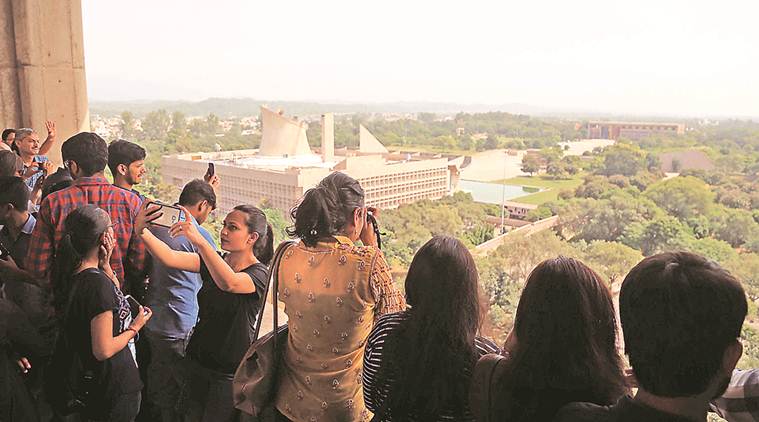 Visitors on the top of Punjab and Haryana Secretariat building during the Heritage Walk at Capitol Complex in Chandigarh on Saturday. (Express photo by Sahil Walia)
Visitors on the top of Punjab and Haryana Secretariat building during the Heritage Walk at Capitol Complex in Chandigarh on Saturday. (Express photo by Sahil Walia)
ON THE 131st birth anniversary of Charles Edourad Jeanneret, known to the world as Le Corbusier, what better way to pay homage to the architect of Chandigarh than to soak in the stark concrete beauty of his masterpiece creation for the city, the Capitol Complex.
Deepika Gandhi, director of Le Corbusier Centre and of the Museum of Architecture, led the way for the 100 or so enthusiasts who turned out for Saturday morning’s special walk. It was a larger than expected gathering, Gandhi said. Some were architects who wanted to refresh their learning and what they knew about the master, some were tourists, others were students and city residents.
Even in his time, Le Corbusier was an enigmatic figure, but Gandhi’s expert commentary made it easy to understand why his name still evokes more than just passing curiosity. He was all in all – a dreamer, a thinker, a visionary urban planner, a builder, an architect, an artist, a designer. Which is why no part of this city as envisioned and built by him is without its own particular meaning, without being “in your face”, as Gandhi said, or “bossing over”.
So, all three buildings in the Capitol Complex stand perpendicular to the Shivaliks, which, were it not for the haze and all the trees that have come up in the last few years, would be visible from the massive plaza connecting the Court and Assembly. Ahead of his time, Corbusier was also a rainwater harvester and a green building maker.
Corbusier hid big symbolism in his designs. Why such a huge expanse in between the two buildings? Perhaps to give each building its architectural due. But perhaps also to emphasise the separateness of the judiciary from the legislature, and still further, and set a little lower, from the executive in the form of the Secretariat. As they stand together, they also underline the importance of the three pillars of a democracy (the media being the fourth).
Even small features have purpose, which Gandhi explained to the group, providing several “a-ha” moments. For instance, the walkway from the plaza to the Open Hand has a low wall on one side but is open on the other. That’s him gently guiding you and your line of vision, without you knowing it, towards the Open Hand. Caught you Corbu! Or take that overbridge leading from Jan Marg to the plaza. The wall on either side is highest at the topmost point of the bridge, just where pedestrians might stop to gaze below, tapering off at either end, where people are least likely to linger.
Some puzzles remain. One is Corbusier’s fascination with the swastika. Here was a Swiss-French genius, about 10 years after the Second World War, with Europe still reeling from what Nazism had inflicted, yet he put in two swastikas: one on the wall of the Martyr’s monument, which also carries a Tricolour; the other in the Punjab Assembly, on one side under the Speaker’s chair. On the other side, appropriately enough, is a stalk of wheat. One explanation is that he wanted a Hindu symbol to denote the new country, but that’s odd for its Nehruvian times. Three years ago, there was a small buzz about Corbu’s alleged fascination for Nazism, but it’s died down since then.
The other is the remoteness of the Capitol Complex from the rest of the city. In most other cities of the world, its most important buildings are centrepieces. Gandhi explained that it only seemed remote, but was actually very connected.
Corbusier had envisioned Jan Marg as a seamless corridor from Sector 17 to the “head” of the city. Perhaps, the increase in security over the years has given it that faraway feel. At the moment, it feels almost as if Chandigarh does not claim enough ownership of this masterpiece.
The big surprise prize of the walk was to get to see the Open Hand turn a few degrees on its pole when a small breeze caught it. Nice birthday gift, Corbu.